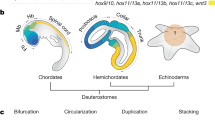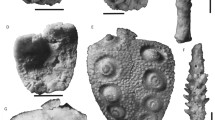Abstract
Diverse sampling of organisms across the five major classes in the phylum Echinodermata is beginning to reveal much about the structure and function of gene regulatory networks (GRNs) in development and evolution. Sea urchins are the most studied clade within this phylum, and recent work suggests there has been dramatic rewiring at the top of the skeletogenic GRN along the lineage leading to extant members of the euechinoid sea urchins. Such rewiring likely accounts for some of the observed developmental differences between the two major subclasses of sea urchins—cidaroids and euechinoids. To address effects of topmost rewiring on downstream GRN events, we cloned four downstream regulatory genes within the skeletogenic GRN and surveyed their spatiotemporal expression patterns in the cidaroid Eucidaris tribuloides. We performed phylogenetic analyses with homologs from other non-vertebrate deuterostomes and characterized their spatiotemporal expression by quantitative polymerase chain reaction (qPCR) and whole-mount in situ hybridization (WMISH). Our data suggest the erg–hex–tgif subcircuit, a putative GRN kernel, exhibits a mesoderm-specific expression pattern early in Eucidaris development that is directly downstream of the initial mesodermal GRN circuitry. Comparative analysis of the expression of this subcircuit in four echinoderm taxa allowed robust ancestral state reconstruction, supporting hypotheses that its ancestral function was to stabilize the mesodermal regulatory state and that it has been co-opted and deployed as a unit in mesodermal subdomains in distantly diverged echinoderms. Importantly, our study supports the notion that GRN kernels exhibit structural and functional modularity, locking down and stabilizing clade-specific, embryonic regulatory states.



Similar content being viewed by others
References
Davidson EH, Erwin DH (2006) Gene regulatory networks and the evolution of animal body plans. Science 311:796–800
Erkenbrack EM, Davidson EH (2015) Evolutionary rewiring of gene regulatory network linkages at divergence of the echinoid subclasses. Proc Natl Acad Sci U S A 112:E4075–E4084
Ettensohn CA (2013) Encoding anatomy: developmental gene regulatory networks and morphogenesis. Genesis 51:383–409
Gao F, Davidson EH (2008) Transfer of a large gene regulatory apparatus to a new developmental address in echinoid evolution. Proc Natl Acad Sci U S A 105:6091–6096
Gao F, Thompson JR, Petsios E, Erkenbrack EM, Moats RA, Bottjer DJ, Davidson EH (2015) Juvenile skeletogenesis in anciently diverged sea urchin clades. Dev Biol 400:148–158
Howard-Ashby M, Materna SC, Brown T, Chen L, Cameron RA, Davidson EH (2006) Identification and characterization of homeobox transcription factor genes in Strongylocentrotus purpuratus, and their expression in embryonic development. Dev Biol 300:74–89
Jell PA (2014) A Tremadocian asterozoan from Tasmania and a late Llandovery edrioasteroid from Victoria. Alcheringa 38:528–540
Materna SC, Ransick A, Li E, Davidson EH (2013) Diversification of oral and aboral mesodermal regulatory states in pregastrular sea urchin embryos. Dev Biol 375:92–104
Mavrothalassitis G, Ghysdael J (2000) Proteins of the ETS family with transcriptional repressor activity. Oncogene 19:6524–6532
McCauley BS, Weideman EP, Hinman VF (2010) A conserved gene regulatory network subcircuit drives different developmental fates in the vegetal pole of highly divergent echinoderm embryos. Dev Biol 340:200–208
McCauley BS, Wright EP, Exner C, Kitazawa C, Hinman VF (2012) Development of an embryonic skeletogenic mesenchyme lineage in a sea cucumber reveals the trajectory of change for the evolution of novel structures in echinoderms. EvoDevo 3:17
Oliveri P, Tu Q, Davidson EH (2008) Global regulatory logic for specification of an embryonic cell lineage. Proc Natl Acad Sci U S A 105:5955–5962
Peter IS, Davidson EH (2011) A gene regulatory network controlling the embryonic specification of endoderm. Nature 474:635–639
Poutska AJ, Kuhn A, Groth D, Weise V, Yaguchi S, Burke RD, Herwig R, Lehrach H, Panopoulou G (2007) A global view of gene expression in lithium and zinc treated sea urchin embryos: new components of gene regulatory networks. Genome Biol 8:r85
Rizzo F, Fernandez-Serra M, Squarzoni P, Archimandritis A, Arnone MI (2006) Identification and developmental expression of the ets gene family in the sea urchin (Strongylocentrotus purpuratus). Dev Biol 300:35–48
Schroeder T (1981) Development of a “primitive” sea urchin (Eucidaris tribuloides): irregularities in the hyaline layer, micromeres, and primary mesenchyme. Biol Bull 161:141–151
Seidel JJ, Graves BJ (2002) An ERK2 docking site in the pointed domain distinguishes a subset of ETS transcription factors. Genes Dev 16:127–137
Solek CM, Oliveri P, Loza-Coll M, Schrankel CS, Ho ECH, Wang G, Rast JP (2013) An ancient role for Gata-1/2/3 and Scl transcription factor homologs in the development of immunocytes. Dev Biol 382:280–292
Soufi A, Jayaraman P (2008) PRH/Hex: an oligomeric transcription factor and multifunctional regulator of cell fate. Biochem J 412:399–413
Thompson JR, Petsios E, Davidson EH, Gao F, Erkenbrack EM, Bottjer DJ (2015) Reorganization of sea urchin gene regulatory networks at least 268 million years ago as revealed by oldest fossil cidaroid echinoid. Sci Rep 5:15541
Wray GA, McClay DR (1988) The origin of spicule-forming cells in a ‘primitive’ sea urchin (Eucidaris tribuloides) which appears to lack primary mesenchyme cells. Development 103:305–315
Yamazaki A, Kidachi Y, Yamaguchi M, Minokawa T (2014) Larval mesenchyme cell specification in the primitive echinoid occurs independently of the double-negative gate. Development 141:2669–2679
Acknowledgments
This work was part of a funding initiative to enhance developmental biology research at undergraduate institutions awarded to LR (National Institutes of Health #1R15HD059927-01). We thank Andy Cameron and his intrepid crew at the Center for Computational Regulatory Genomics at Caltech’s Beckman Institute for their assistance with sequences. EME conducted the spatiotemporal aspect of this research in the Davidson Laboratory and was funded by National Science Foundation CREATIV grant #1240626. The authors wish to dedicate this paper to the memory of Eric Harris Davidson.
Author information
Authors and Affiliations
Corresponding author
Additional information
Communicated by Hiroki Nishida
Rights and permissions
About this article
Cite this article
Erkenbrack, E.M., Ako-Asare, K., Miller, E. et al. Ancestral state reconstruction by comparative analysis of a GRN kernel operating in echinoderms. Dev Genes Evol 226, 37–45 (2016). https://doi.org/10.1007/s00427-015-0527-y
Received:
Accepted:
Published:
Issue Date:
DOI: https://doi.org/10.1007/s00427-015-0527-y




